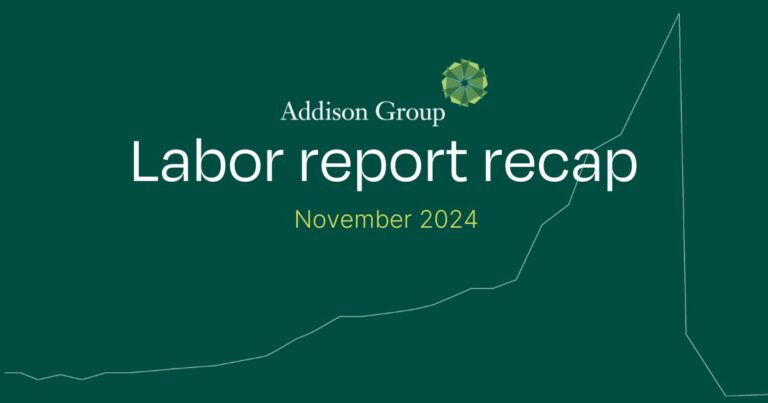National hiring & employment trends for 2025: What to expect

If your neck aches from the whiplash of the US job market over the past few years, you are not alone. The swift pivot from massive hiring to major layoffs has been a pain point for both employers and job candidates. As we head towards the end of 2024 and look ahead to national hiring trends for next year, we can report a mix of good news and challenges. While geopolitical and inflation concerns continue, there is some optimism with a rise in consumer spending, business investments, and a strong job market.1
Yet factors such as shifting cultural tides and new labor laws are not making hiring any easier. To attract and recruit the best candidates in today’s market, employers need to stay a step ahead of the competition. Here’s what to expect in 2025.
Optimism mixed with caution
Unlike the roller coaster ride of the past few years, this year’s labor market has calmed somewhat and outperformed economists’ expectations with steady job growth over the past five straight quarters.2 Wage increases are averaging 4.5% in 2024, down from 4.8% in 2023 but still higher than pre-pandemic levels.3 Hot industries like Information Technology, Engineering, and Finance are the exception as firms vie for top talent.
Overall, demand for top talent is still tight. Although the labor market has cooled, it’s not translating into top talent being readily available. If anything, employers have just had to spend more time sifting through applications.
Experts still predict a job slowdown with 4% unemployment and companies expected to create half as many jobs by March 20254. In what may be related to ‘burnout’ from the frantic hiring cycle of the past few years, employers and candidates are now taking much longer to make hiring decisions with high expectations on both sides.
Companies want more skills and loyal team members and candidates want not only compensation, but benefits and culture. This has translated into longer interview processes that lead to extended job vacancies impacting productivity and morale.
Workers are poised to get smaller raises and their annual pay bumps are unlikely to increase again anytime soon amid a cooler job market. 6
– CNBC
Heading into 2025, companies who are short on talent may need to rethink their hiring approach. Companies who hesitate on filling positions should consider the financial costs of vacancies which can range from $4,000-$6,000 a month, depending on the industry and role.5 Employers who add many extra interviews and draw out the process in hopes of finding the ‘perfect’ candidate risk losing out on top candidates.
A new normal in flexibility

While there’s no ‘one size fits all’ approach to how and where we work, companies have experienced a major pendulum shift from primarily remote work after the pandemic to more hybrid positions and a shift back to the office in the last year.
Major employers Google, Apple, and Meta actively recalled team members to the office, expressing concerns about productivity, collaboration, and company culture. That has extended to many more industries with companies such as Kohl’s Department Stores following suit.
A new normal that emphasizes both in-office and hybrid roles is emerging. While it’s becoming harder to find totally remote roles in many industries, they are still popular in technology and nonclinical healthcare roles – especially in Revenue Cycle Management.
New labor laws are impacting hiring
Federal, state, and local labor laws passed in 2024 will impact hiring decisions. Twenty-two states are increasing minimum wage for an estimated 9.9 million workers. This is already impacting major markets like Seattle, Washington, which now has the highest state minimum wage increased from $15.74 to $16.28.8
Pay transparency laws requiring salary disclosure to job applicants have been enacted in many states including New York and Ohio. Others such as Illinois begin in 2025.9
States such as California, Minnesota, and Illinois have enacted new sick laws which are expanding the amount of paid sick leave and PTO employees can accrue. More states are expected to follow suit in 2025.10
90% of companies say they will return to the office this year – but for the most part the five-day commute is dead 6
– CNBC
The US Department of Labor also increased exempt employee salary thresholds in 2024, resulting in an estimated 4 million additional employees now eligible to receive overtime. This varies by state, but, on average, is increasing from $35,568 per year to $43,888 per year on July 1 and will increase again to $58,656 per year on Jan. 1, 2025.11
Businesses will need to adjust their recruitment strategies to accommodate the higher labor costs. This may cause employers to pause on hiring and be more selective, seeking candidates with the necessary skills and experience to maximize productivity.
Culture takes a front seat
After several years of massive talent shortages which had employers scrambling for talent, the tide has turned. Now culture is back in the spotlight and in almost every industry, employers are again prioritizing finding the right talent vs. filling an opening.
Candidates, too, have been burned-out by switching jobs for higher salaries, only to learn that they made a mistake. Now in addition to skills, Addison Group is seeing culture fit is a priority to ensure a candidate matches an organization’s beliefs, behavior, and values.12 When employees feel seen and valued, they are more confident about organizational change. They are also 18x more likely to say that they hope to be at their organization in a year and 5x more likely to say they plan to stay for at least three more years.13
For valuable insights and national averages of salaries across hundreds of roles in administrative, digital marketing, finance, accounting, healthcare, human resources, and information technology, download your free copy today.
- https://www2.deloitte.com/us/en/insights/economy/us-economic-forecast/united-states-outlook-analysis.html
- https://www.bankrate.com/banking/federal-reserve/economic-indicator-survey-jobs-april-2024/
- https://www.payscale.com/compensation-trends/labor-market-update-the-2024-2025-salary-budget-survey-sbs-is-now-open-for-participation/#:~:text=According%20to%20Payscale’s%202024%20Compensation,leading%20up%20to%20the%20pandemic.
- https://www.bankrate.com/banking/federal-reserve/economic-indicator-survey-jobs-april-2024/
- https://www.businessmanagementdaily.com/46997/shrm-survey-average-cost-per-hire-is-4129/
- https://www.cnbc.com/2024/01/05/why-workers-raises-are-smaller-in-2024-and-may-not-go-up-from-here.html
- https://www.cnbc.com/2023/09/11/90percent-of-companies-say-theyll-return-to-the-office-by-the-end-of-2024.html
- https://www.epi.org/minimum-wage-tracker/#/min_wage/Washington
- https://www.payanalytics.com/resources/articles/us-pay-transparency-laws-by-state
- https://www.hr-brew.com/stories/2024/01/17/paid-sick-leave-laws-take-effect
- https://www.bhfs.com/insights/alerts-articles/2024/u-s-department-of-labor-raises-exempt-employee-salary-thresholds
- https://hrinterviews.com/insight/importance-of-cultural-fit-in-hr-recruitment/
- https://www.octanner.com/articles/employee-retention-guide









